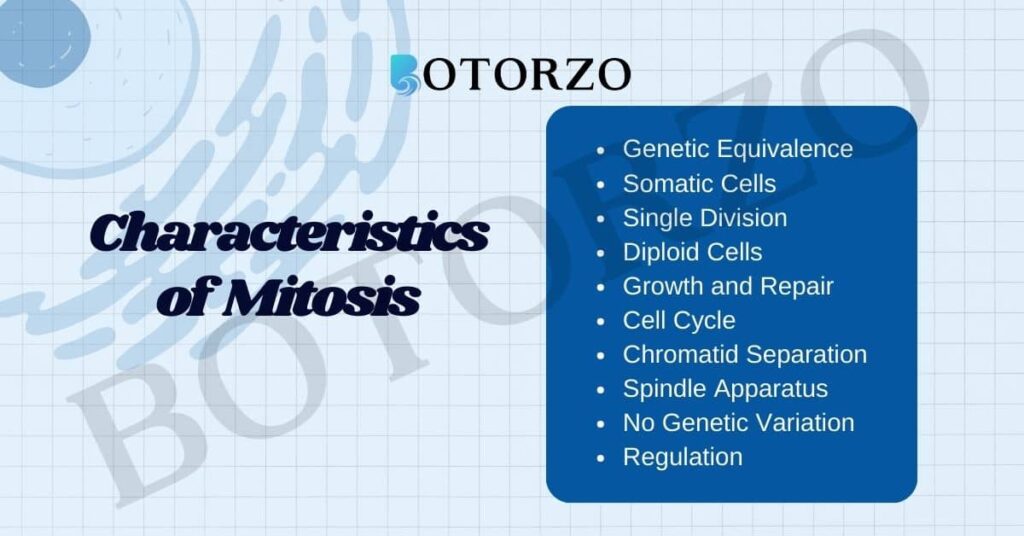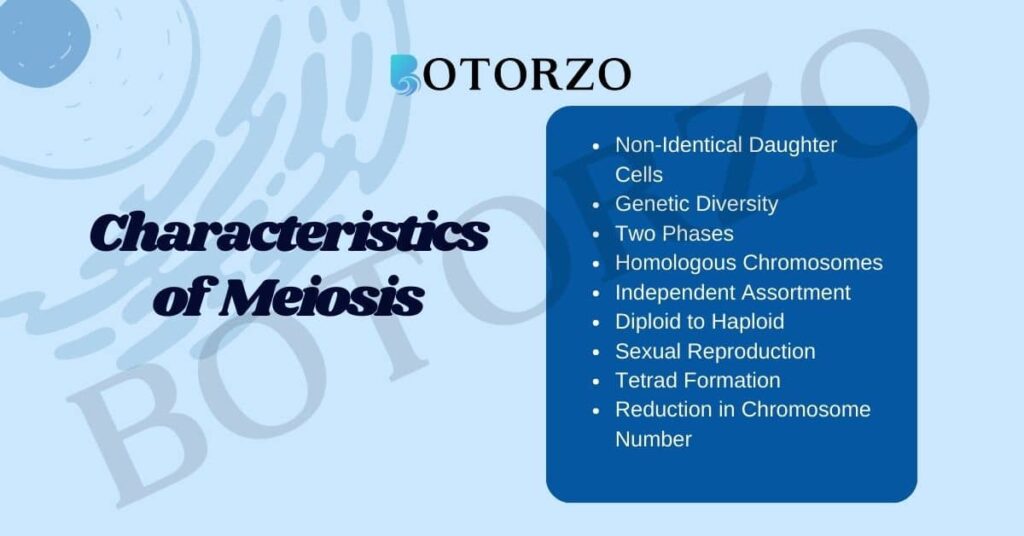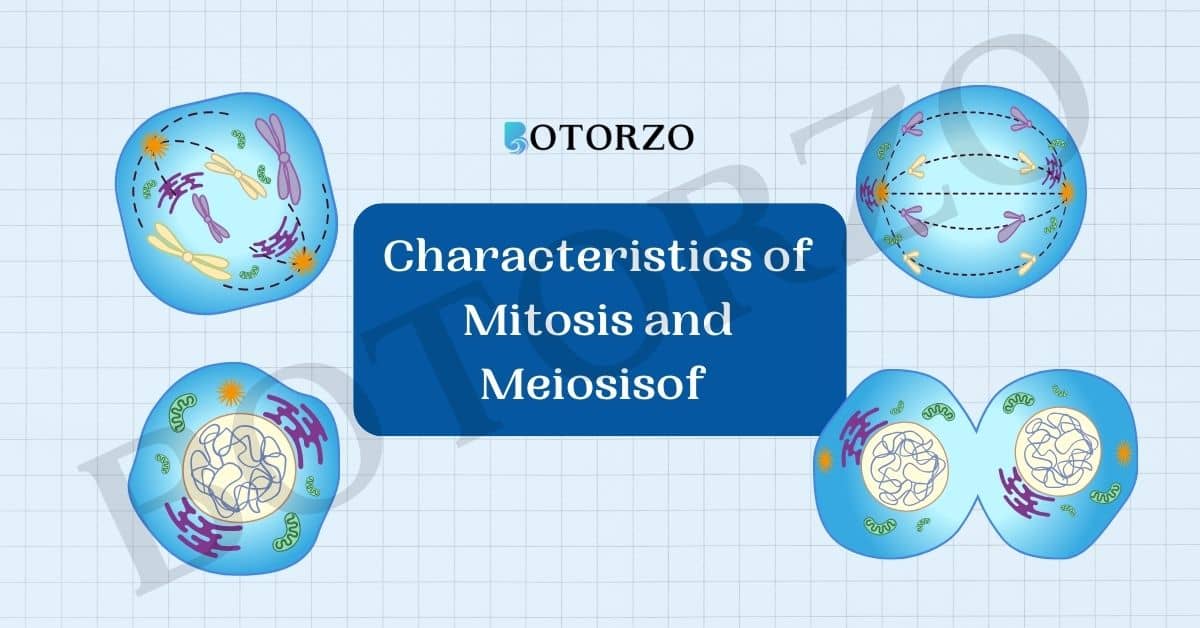What is the importance of mitosis and meiosis in the body? In today’s post, we will read about the characteristics of mitosis and characteristics of meiosis.
A single cell divides to make new cells, which is a fundamental biological function. Mitosis and meiosis are two major types that play separate roles. Mitosis produces two identical daughter cells, which are required for growth and tissue repair. Meiosis, on the other hand, produces four non-identical germ cells, which are required for sexual reproduction. The process is highly controlled and has far-reaching ramifications for development, health, and disease.
More information on the mechanisms and relevance of cell division may be found here.
Characteristics of Mitosis
Mitosis is a fundamental process of cell division that occurs in somatic (body) cells. It is responsible for creating two identical daughter cells, each with the same number of chromosomes as the parent cell. Here are 10 characteristics of mitosis:

- Genetic Equivalence: Mitosis results in two daughter cells that are genetically identical to the parent cell. They have the same number of chromosomes and the same genetic information.
- Somatic Cells: Mitosis occurs in somatic cells, which make up the body of an organism, and not in germ cells, which are involved in sexual reproduction.
- Single Division: Mitosis involves a single-cell division. It is sometimes referred to as “equational division” because it maintains the chromosome number in the daughter cells.
- Diploid Cells: The daughter cells produced by mitosis are diploid (2n), meaning they have two sets of chromosomes—one from each parent.
- Growth and Repair: Mitosis plays a crucial role in the growth and development of multicellular organisms and in the repair and replacement of damaged or dead cells.
- Cell Cycle: Mitosis is a part of the larger cell cycle, which includes interphase (G1, S, and G2 phases) and the mitotic phase (prophase, metaphase, anaphase, and telophase).
- Chromatid Separation: During mitosis, the sister chromatids of each chromosome separate and move to opposite poles of the dividing cell. This ensures that each daughter cell receives a complete set of chromosomes.
- Spindle Apparatus: Mitosis involves the formation of a spindle apparatus, a structure made of microtubules, which helps in the separation of chromatids.
- No Genetic Variation: Mitosis does not lead to genetic diversity because it produces genetically identical cells. It is not involved in the creation of new combinations of genes.
- Regulation: Mitosis is tightly regulated by various checkpoints and cell cycle control mechanisms to ensure accurate replication and division of the genetic material.
Characteristics of Meiosis
Meiosis is a type of cell division that occurs in germ cells, specifically in the production of gametes (sperm and egg cells). It is essential for sexual reproduction and introduces genetic diversity. Here are 10 characteristics of meiosis:

- Meiosis is characterized by two sequential divisions that result in four non-identical haploid (n) daughter cells, each with half the number of chromosomes as the parent cell.
- Genetic Diversity: Unlike mitosis, meiosis promotes genetic diversity through mechanisms like as crossing-over and random chromosome assortment, resulting in offspring with unique gene combinations.
- Two Phases: Meiosis consists of two main phases, Meiosis I and Meiosis II, each with prophase, metaphase, anaphase, and telophase stages.
- Homologous Chromosomes: During meiosis, homologous chromosomes (chromosomes with similar genes) pair up and undergo genetic exchange in a process known as crossing-over.
- Independent Assortment: Chromosomes line up randomly during metaphase I, leading to a random assortment of maternal and paternal chromosomes in the daughter cells.
- Diploid to Haploid: Meiosis reduces the chromosome number from diploid (2n) to haploid (n) to prepare gametes with half the genetic information.
- Sexual Reproduction: Meiosis is the process by which eggs and sperm are produced, and it is essential for the fusion of gametes during fertilization.
- Tetrad Formation: During prophase I, homologous chromosomes form pairs known as tetrads, facilitating crossing-over and genetic recombination.
- Reduction in Chromosome Number: Meiosis I separates homologous chromosomes, while Meiosis II separates sister chromatids, ultimately reducing chromosome number by half.
- Non-Identical Daughter Cells: The four daughter cells produced by meiosis are genetically distinct, leading to the genetic variability necessary for evolution and adaptation.
Characteristics of Mitosis and Meiosis
| Characteristic | Mitosis | Meiosis |
| Purpose | Growth and tissue maintenance | Sexual reproduction |
| Number of Divisions | One division | Two consecutive divisions |
| Number of Daughter Cells | Two identical daughter cells | Four daughter cells, each with half the number of chromosomes |
| Genetic Variation | No significant genetic variation | Significant genetic variation |
| Chromosome Number | Daughter cells have the same number of chromosomes as the mother cell | Daughter cells have half the number of chromosomes compared to the mother cell |
| Occurrence | Occurs in somatic cells (body cells) | Occurs in specialized reproductive cells |
| Role in Evolution | Maintains genetic stability | Generates genetic diversity for adaptation and evolution |

